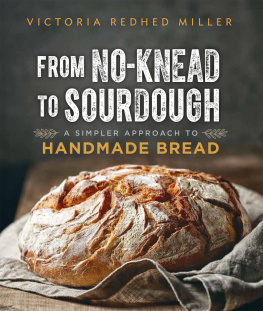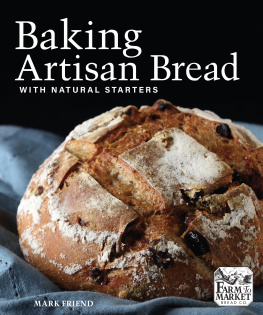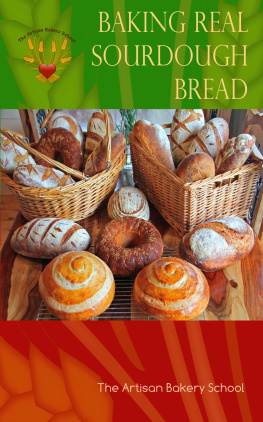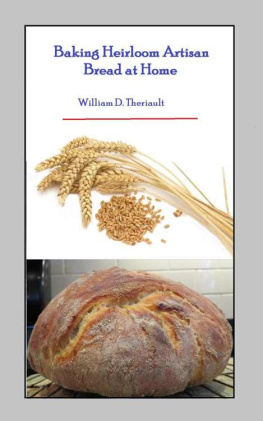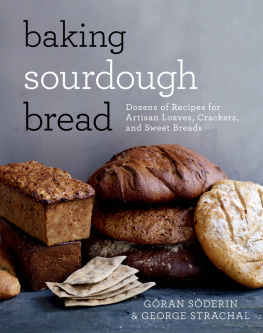
Faster Artisan Breads II: Sourdough
The Artisan Bakery School
All contents copyright Penny Williams and Dragan Matijevic 2015
***
Published by Pendragan Publishing

***
This book cannot be copied, reprinted or redistributed for sale by any mechanical, electronic or other means. The design, photographs and text remain the properties of the authors.
The information contained in this text has been verified and documented as carefully as possible. The authors cannot be held liable for the use of its contents.
***
Pendragan Publishing
Old Home Cottage
Sparkwell
Plymouth PL7 5DQ
United Kingdom
First Edition 2013
Table of Contents
Faster Artisan Breads (FABs) Using Sourdough Culture

Faster Artisan Breads II focuses on using sourdough - a natural, wild yeast culture - to create breads of exceptional character and nutritional value.
If youre already using our most popular book, Baking Real Sourdough Breads, youll notice a few similarities in background information, but the key emphasis here is on our outstanding new FAB method and the new delicious recipes. The FAB method is more advanced and even simpler to use. If youre altogether new to baking, welcome! You have found an excellent place to start.
Sourdough is traditionally slo-mo dough. People naturally conclude that it should take hours of effort to make, and they often give up before they start. In fact, nothing could be further from the truth. Our FAB method uses 100% natural sourdough starter and yet takes only four minutes of hands-on work!
If you dont have a sourdough culture, and cant beg one from a friend, then you can easily make your own in about five days, just one minute a day. Once you have made the culture, it can last a lifetime. Full instructions are given in the chapter headed Sourdough Magic.
There are two secrets to the FAB method. The first lies in using your fridge. This is not a new thing, in fact it is common practice in both artisanal baking and factory bread production to slow down the rate at which dough develops, by chilling it. But we dont know of anyone who has streamlined the process quite like we have.
The second secret is that, contrary to popular belief, you dont actually have to knead your dough. Recent research proves that, provided you add sufficient water and mix the dough well, the absorption of the water and the consequent development of the gluten will happen anyway, kneading or no kneading, so long as you leave the dough to rest for long enough.
The FAB Sourdough Method will help anyone from the complete novice to the seasoned professional to make delicious, healthy and beautiful breads with minimum effort, maximum effect and absolutely no cutting corners, in just three simple steps.

Happy baking!
Dragan and Penny
Why Sourdough?

Hand-made organic sourdough is the most natural form of bread you can eat.
Thats because the sourdough culture - the ingredient that raises the dough - is made from the wild yeasts that occur naturally in the flour itself, and in the surrounding environment. The more aggressive strains of commercial bakers yeast can be completely avoided.
Hand-made sourdough is also a healthier choice because of the length of time it takes for the dough to ripen. Compare less than sixty seconds for a factory loaf to rise with sixty hours in the fridge for a sourdough. The longer the dough matures, the better it is for your digestion.
The benefits of sourdough bread:
Sourdough bread offers health benefits that factory-produced breads full of additives cannot.
1. Thanks to the lactic and acetic acids, the gluten is modified and made far more digestible
2. Sourdough bread satisfies hunger, rather than provoking it
3. It releases sugars more slowly, avoiding the spike/crash effect
4. The crumb is chewier and the crust is crisper
5. The taste is richer, more complex and more enjoyable
6. Sourdough loaves look fabulous!
7. Sourdough bread lasts longer due to its own natural acids acting as preservatives
Because wild yeasts vary according to their environments, a San Francisco sourdough will naturally be different to a Devon sourdough or one made in Croatia, or anywhere else in the world. Yours will be unique to where you live. The taste of real sourdough will never be truly sour but it will range in flavour across the spectrum from milky to vinegary, (lactic to acetic acids) depending on how long you leave the starter and the dough to mature.
Contrary to popular myth, baking real sourdough breads need not take hours away from your day. We will show you that, with a little bit of forward planning, it need take only a few minutes. It does take time to ferment, but you can sleep, work, play and generally ignore the dough for days on end so long as it is in a cold enough place. It will quietly continue its life, patiently waiting for you to come back, shape it, and bake it.
Real sourdough bread can be made with organic white, wholemeal, rye or heritage flours. You can combine the flours to create a huge variety of textures, looks and tastes. You can also add a range of other ingredients to produce a sourdough loaf to suit every occasion and match every menu.
Important Starting Tips

First, please leaf through the whole book before you start. This will help you organise your thinking and your kitchen, so you dont get all floury and frustrated half way through.
Have your baking gear and ingredients lined up in one place. This makes you feel more efficient, which will result in your being more effective.
Remind yourself that you are embarking on a simple, direct method for making natural sourdough bread that will take no more than four minutes of physical effort. Its a smart choice, not a chore!
Get in the habit of measuring your ingredients as precisely as you can. Professional bakers all over the world use digital scales to weigh the ingredients in grams and kilograms, and you will get better results if you do the same. Weigh the water (grams of water and milliliters are the same) on the scales too, as the calibration on measuring jugs is often unreliable. A few grams more or less water can produce quite different results, not all of which will be that appetising.
If you do decide to use cups and spoons, be aware that different flours have different densities, a cup of white flour A will weigh differently from a cup of white flour B. The best way forward then is to develop a feel for your dough. Make it soft, pliable and not too sticky, and remember that different flour types will require different amounts of water, and this will vary according to the ambient temperature and humidity. Baking in summer and winter are different things.
Next page


![Ken Forkish - Evolutions in Bread: Artisan Pan Breads and Dutch-Oven Loaves at Home [A baking book]](/uploads/posts/book/323066/thumbs/ken-forkish-evolutions-in-bread-artisan-pan.jpg)
